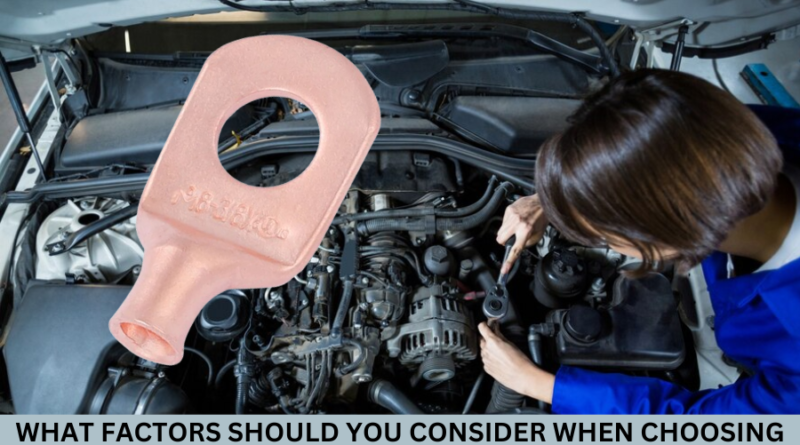Key Factors for Choosing an 8 AWG Terminal Lug
Choosing the right terminal lug might seem like a simple task. However, there are several key factors that can significantly impact longevity. Efficiency, and safety of your electrical connections. In the world of electronics and wiring, even the smallest details can make a big difference. Selecting an improperly sized or incompatible terminal lug can lead to a number of problems, including:
- Increased Resistance: A loose or poorly crimped connection creates an obstacle to the flow of electricity. Resulting in increased resistance. This resistance can cause heat buildup at the connection point, potentially damaging the terminal lug. The wire itself, or surrounding components.
- Voltage Drop: Increased resistance also leads to voltage drop. This means the voltage reaching your device is less than the voltage supplied by the source. This can cause flickering lights, malfunctioning equipment, or even a complete loss of power.
- Corrosion and Connection Failure: Over time, a poor connection is exposed to moisture. or contaminants can accelerate corrosion. Corrosion creates a buildup of insulating material that further hinders electrical flow. And can ultimately lead to complete connection failure.
By carefully considering the factors outlined in this blog. You’ll be well-equipped to choose the optimal 8 AWG terminal lug for your project. This will ensure a strong, reliable connection that minimizes resistance, prevents voltage drop. And protects against corrosion for long-lasting performance and safety.
Understanding 8 AWG
Before we dive into the specifics, let’s clarify the significance of “8 AWG.” AWG stands for American Wire Gauge, a standardized system for determining wire diameters. An 8 AWG wire has a specific diameter and current-carrying capacity. Designed to meet the needs of electrical applications safely. Selecting a terminal lug that perfectly matches your 8 AWG wire is essential for ensuring a strong, reliable connection.
Key Considerations When Choosing an 8 AWG Terminal Lug
- Material: The material of the terminal lug greatly impacts its conductivity. Corrosion resistance, and overall durability. Here are some common options:
- Lead: The most traditional material for battery connector lugs. Offering affordability and reasonable conductivity. However, lead is more susceptible to corrosion than other metals.
- Copper: Offering exceptional electrical conductivity. Copper is a great choice for high-performance applications where minimal resistance is critical. It is also naturally more resistant to corrosion when compared to lead.
- Tin-plated Copper: Provides the superior conductivity of copper with a tin coating. that offers enhanced corrosion resistance. Making it a great choice for marine or harsh environments.
- Stud Size: The stud size corresponds to the screw or bolt size on the device or apparatus to which you’ll be attaching the terminal lug. Ensure that the hole within the ring or spade terminal matches the stud size of your intended connection point. Improper sizing can lead to loose connections that will fail due to excessive resistance and heat buildup.
- Connector Type: Select the connector type that best suits your application:
- Ring Terminals: Designed with a closed ring for secure fastening to a bolt or stud. These are ideal for creating permanent connections. Such as grounding systems or battery installations.
- Fork/Spade Terminals: Featuring a U-shaped fork. These are designed to slide over a screw or stud and provide a secure connection while still being relatively easy to remove if necessary.
- Bullet Connectors: Used to create quick-disconnect connections. With male and female bullet terminals that can be easily connected and disconnected.
- Butt Connectors: Used to splice two wires together end-to-end. These come in various options including uninsulated, heat shrink, and even quick disconnect types.
- Environmental Conditions: If your application involves exposure to the elements. Moisture, or extreme temperatures, consider the terminal lug’s environmental ratings and choose accordingly.
- Harsh Environments: For outdoor applications, marine environments, or situations. Where vibrations are common, look for sealed or tin-plated connectors to minimize corrosion.
- Vibration Resistance: If vibration is a factor, choose terminal lugs with added design features. Like locking teeth or crimping indentations that create a firm grip on the wire to maintain a solid connection.
- Standards and Regulations: Certain industries or projects may have specific standards. Or regulations that must be followed. Verify if your application requires adhering to certifications such as:
- UL (Underwriters Laboratories): Verifies electrical safety standards for specific applications and environments.
- SAE (Society of Automotive Engineers): Sets standards relevant to automotive applications.
- Military Specifications: MIL-SPEC terminals may be required for applications within the defense. or the aerospace industry.
Additional Considerations
- Crimp Quality: Always use a high-quality crimping tool designed for 8 AWG wire and your chosen 8 AWG single-wire lug. A proper crimp is essential for creating a reliable, low-resistance connection.
- Insulation: Depending on your application and the connector type. You may want to use heat shrink tubing to provide insulation where the uninsulated portion of the wire exits the connector.
Importance of Making the Right Choice
Selecting the correct 8 AWG single-wire lug isn’t merely about finding a connector with a hole that fits your wire. By carefully considering the material, stud size, connector type, environmental conditions. And any relevant standards, you’ll ensure a durable and safe connection. That maximizes the performance of your electrical systems. Investing a bit of time upfront saves a lot of frustration and potential problems down the line!

